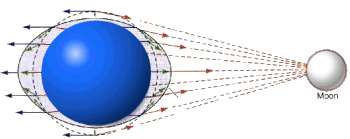Tides
|
NATURE'S SOUP: Tides |
|

Tides are formed by the pull of the Sun and Moon upon the earth and the waters that surround the earth. As the earth rotates in its daily orbit, water closest to the moon will be pulled toward the moon, creating a high tide (A). Water at a 90 degree angle will be less affected by the moon, causing a condition of low tide (B). Surprisingly, water on the other side of the earth (C) will be at high tide, as well. That is because the centrifigal force of the rotating earth becomes greater on the backside of the earth than the gravitaional force. However, the high tide at point C will be slightly lower than the high tide at point A.
Each day waters along the East Coast experience two high tides and two low tides. Because the moon is also orbiting the earth at the rate of 28 days per revolution, each day the moon will be 1/28th of a day further than the day before or about 52 minutes later. So each day the high tides or low tides will be about 52 minutes later than the day before.
The sun also affects the strength of the tides. When the sun, moon, and earth are lined up, the tides are strongest. This occurs twice a month. Those two phases of the moon are called a new moon (completely dark) and a full moon (completely bright). The other two phases are quartering moons (half illuminated). The new and full moons create a stronger high and low tide, called a spring tide. The quartering moons create neap tides, which are more moderate.
Because of the shape of the Georgia coast line (known as the Georgia or Southatlantic Bight), more water is pushed into the tidal marshes, creating a tidal range of 6 to 9 feet. Contrasted with the 2-3 foot tides normally seen in Florida and the Carolinas, the tidal marshes in Georgia experience a much greater flood and ebb than marshes in the neighboring states. This creates a profound mixing of Nature's Soup in Georgia.